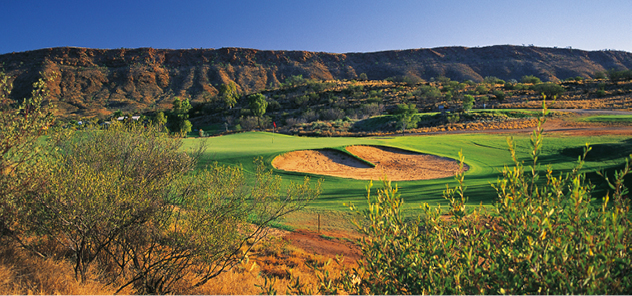
Early in the morning or late in the day are the best times to witness the colourful splendour of a round at Alice Springs, Australia’s only true desert course of championship standard. The beautifully maintained playing surfaces are various shades of green. Surrounding the rocky undergrowth wide of the fairways are the reds and yellows of desert soil. Forming a majestic backdrop to it all is the ochre glow of the MacDonnell Ranges. Having been heated all day, the ranges continue to glow long after the sun has disappeared to the west.
It makes for a spectacular golfing setting, one that cannot be experienced anywhere else in Australia. Saltwater fescue fairways, couch grass and tifdwarf greens grow healthy out of red sand, thriving on the salty bore water that irrigates them. The course was designed by Peter Thomson and Mike Wolveridge and began welcoming players in November 1985. Greg Norman, the year before winning his first British Open, marked Alice Springs’s opening with an exhibition match against American Johnny Miller – and went on to shoot a six-under 66, a course record that stood for many years and has since been broken by two shots by local players Kerryn Heaver and Leigh Shacklady.
The course was the vision of a private consortium that approached the club in the early 1980s. Their plan was to transform the barren fairways and sand-scrape greens into a fully grassed par-72 layout, and to surround it with upmarket houses overlooking the course. It is a long way from the dusty handful of holes along the Todd River that the club called home in the 1940s.
Alice’s 1st hole is a tame one: a 337-metre par-four, with a wide fairway and large green, a chance to get your round started in the best possible way. Make it count, though, for the 2nd is much tougher. At 404 metres, this par-four features a rocky range to the right and an out-of-bounds left. Nor does the green, which is enormous and undulating, take the pressure off.
Most of the fairways on Alice Springs’s front nine are flanked by sand, rock and wispy grass. Miss the green stuff and you receive a serious reality check when you are playing golf in the desert.
The view from the elevated tee at the 171-metre 3rd, one of two signature holes, is breathtaking. The MacDonnell Ranges stretch out beyond a wide green, guarded front and right by bunkers. Every hole on the front nine is enjoyable, but best of all is the 386-metre, par-four 8th. The fairway snakes between two ranges of the roughest of roughs. It veers past a sand trap cut into a hill and down to the green, where three bunkers short and another one long lie in wait.
The back nine crosses over the flattest areas of the course and involves less trouble away from the fairways – until, that is, you reach the par-four 17th. A fairway bunker on the right is within easy reach, forcing players to drive to the left. This brings one of only three water hazards on the entire course into play for your approach to the green. A short iron is all that is required, but when you haven’t been faced with a water carry all day it does make you think twice about the shot.
This is a fun golf course. Good shots are rewarded and bad shots penalised. And though any round here is challenging, the novice player is allowed plenty of room for error.
|
MEMORABLE HOLES 2nd, 3rd, 6th, 8th, 16th, 17th and 18th WHERE TO GO Cromwell Dr, Alice Springs, NT 0871 BOOK A ROUND (08) 8952 6575, www.alicespringsgolfclub.com.au OTHER 120 GREAT COURSES NEARBY Royal Adelaide (1533 km) WHERE TO STAY Crowne Plaza Alice Springs and the Desert Palms Resort overlook the back nine. Both are highly regarded and offer a variety of accommodation styles to suit all budgets. BEFORE/AFTER YOUR ROUND The locals joke that many tourists expect to find Uluru at the end of the main street of Alice Springs. It is in fact 441 km away, requiring at least a full day or an overnight road trip. |
